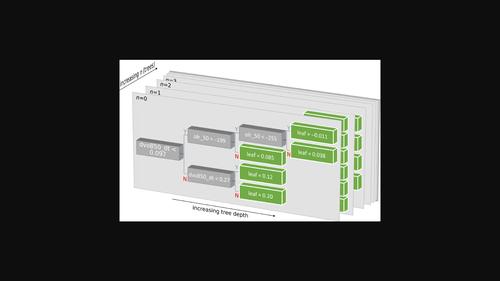利用可解释的梯度增强决策树集合揭示控制季风低压系统的新动力关系
IF 3
3区 地球科学
Q2 METEOROLOGY & ATMOSPHERIC SCIENCES
引用次数: 0
摘要
摘要:低压系统是南亚季风的主要雨源。然而,它们与大尺度季风环流的相互作用,以及它们所经过的高度变化的陆地和海洋表面,是复杂的,通常不被很好地理解。在本文中,我们提出了一种新颖的,自上而下的方法来研究这些关系,并量化它们在描述LPS行为中的重要性。我们还表明,如果方法是足够好的,它是有效的假设生成。对于五个预测指标(即LPS增强率、传播速度/方向、登陆后存活、峰值强度和降水率)中的每一个,我们使用XGBoost算法训练了一个可加性决策树集成模型。然后将Shapley值分析应用于模型,以确定哪些变量是重要的预测因子,并建立它们与预测因子的关系,并在感兴趣的情况下进行额外的分析。利用该技术建立的新关系包括:低涡度在对流日循环高峰发生的清晨优先增强,垂直风切变抑制强低涡的持续增长,大尺度正压不稳定性在低涡的内陆穿透和峰值强度中都起着重要作用。低涡的传播取决于低涡的深度,较浅的低涡受低层风的平流,而较高的低涡受中层风的平流。我们还使用这个框架来确定和讨论季风lps研究的潜在新途径。本文章由计算机程序翻译,如有差异,请以英文原文为准。

Using interpretable gradient‐boosted decision‐tree ensembles to uncover novel dynamical relationships governing monsoon low‐pressure systems
Abstract Low‐pressure systems (LPSs) are the primary rainbringers of the South Asian monsoon. Yet, their interactions with the large‐scale monsoon circulation, as well as the highly variable land and sea surfaces they pass over, are complex and generally not well understood. In this article, we present a novel, top‐down approach to investigate these relationships and quantify their importance in describing LPS behaviour. We also show that, if the approach is sufficiently well posed, it is productive at hypothesis generation. For each of five predictands (i.e., LPS intensification rate, propagation speed/direction, post‐landfall survival, peak intensity, and precipitation rate) we train an additive decision‐tree ensemble model using the XGBoost algorithm. Shapley value analysis is then applied to the models to determine which variables are important predictors and to establish their relationship with the predictand, with additional analysis following cases of interest. Novel relationships established using this technique include that LPS vorticity intensifies preferentially in the early morning at the same time as the peak in the diurnal cycle of their convection occurs, that vertical wind shear suppresses continued growth of strong LPSs, that large‐scale barotropic instability plays an important role in both the inland penetration and peak intensity of LPSs, and that LPS propagation depends on the depth of its vortex with shallower LPSs advected by low‐level winds and taller LPSs advected by mid‐level winds. We also use this framework to identify and discuss potential new avenues of research for monsoon LPSs.
求助全文
通过发布文献求助,成功后即可免费获取论文全文。
去求助
来源期刊
CiteScore
16.80
自引率
4.50%
发文量
163
审稿时长
3-8 weeks
期刊介绍:
The Quarterly Journal of the Royal Meteorological Society is a journal published by the Royal Meteorological Society. It aims to communicate and document new research in the atmospheric sciences and related fields. The journal is considered one of the leading publications in meteorology worldwide. It accepts articles, comprehensive review articles, and comments on published papers. It is published eight times a year, with additional special issues.
The Quarterly Journal has a wide readership of scientists in the atmospheric and related fields. It is indexed and abstracted in various databases, including Advanced Polymers Abstracts, Agricultural Engineering Abstracts, CAB Abstracts, CABDirect, COMPENDEX, CSA Civil Engineering Abstracts, Earthquake Engineering Abstracts, Engineered Materials Abstracts, Science Citation Index, SCOPUS, Web of Science, and more.

 求助内容:
求助内容: 应助结果提醒方式:
应助结果提醒方式:


